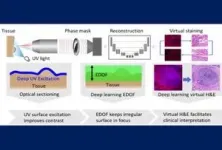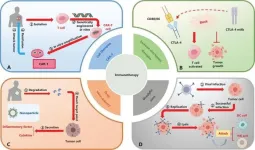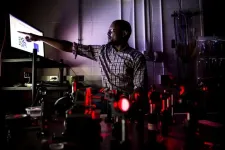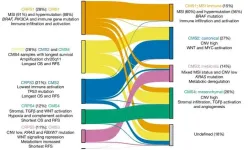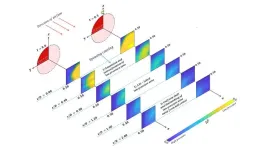(Press-News.org) JUPITER, Fla. — Children born with a damaged gene needed for healthy brain development, SYNGAP1, experience seizures, sensory processing disorders, difficulty speaking, intellectual disability, and autism-like behaviors. It’s a condition without any treatments, one that’s hard both on parents and children, said Gavin Rumbaugh, Ph.D., a neuroscientist at The Herbert Wertheim UF Scripps Institute for Biomedical Innovation & Technology.
Rumbaugh and a team of scientists from the institute have been awarded a five-year grant from the National Institute of Mental Health worth $7.7 million to work toward a treatment. Their goal is to create a pill that restores healthy SYNGAP1 gene production, thereby boosting neuroplasticity, or the ability of the brain to form circuits and connections. The scientists’ hope is that their work will improve the quality of life for both children and adults with the disorder, Rumbaugh said. Collaborators on the grant include Wertheim UF Scripps scientists Courtney Miller, Ph.D., and Ted Kamenecka, Ph.D..
“Seizures can be induced in these children by something as simple as eating the wrong texture of food,” Rumbaugh said. “The benefit of a medication you could take as a pill is that the dose could be adjusted as the children grow.”
When working properly, the SYNGAP1 gene helps the brain assemble the circuits needed to process the senses and learn, Rumbaugh discovered. Mutations can impair this process, with varying outcomes. People have two copies of each gene. Often, a mutation that knocks out one working copy isn’t a problem. But with SYNGAP1, losing both gene copies is fatal, and partial or complete loss of one copy can be debilitating, Rumbaugh said.
“Children born with the most serious SYNGAP1 mutations may have many seizures a day, difficulty walking, difficulty communicating, and difficulty sensing pain. Some require caregivers for their entire lives,” he said. “It’s only in recent years, with more available genetic sequencing and social media, that families have begun to find each other, enabling studies that estimate the prevalence of the mutations.”
Advocacy groups connecting families include the Syngap1 Foundation, and the SynGAP Research Fund.
The condition is rare. One estimate suggests that about 200 babies a year are born with a SYNGAP1 mutation in the United States. Since its discovery in 2009, more than 1,000 people have been diagnosed. Up to 2% of people with intellectual disability may have a SYNGAP1 mutation, Rumbaugh said.
The new grant, from NIMH’s National Cooperative Drug Discovery/Development Groups for the Treatment of Mental Disorders division, will enable the scientists to refine their work on oral medicines to restore SYNGAP1 levels. The scientists hope that a drug able to boost SYNGAP1 might benefit others types of patients as well. It’s possible that people recovering from strokes, or people with brain and nervous system degeneration might also benefit, Rumbaugh said.
“Our work has shown that SYNGAP1 is a potent activator of neuroplasticity, or the ability to make new connections based on experience,” Rumbaugh said. “Because our experimental therapeutics stimulate SYNGAP1 expression, we expect that if our development process creates drug candidates with the desired properties, they will be useful in the SYNGAP1 genetic disorder, but they may also assist with other disorders that affect intellectual functioning.”
The Wertheim UF Scripps Institute is unusual because on one campus, experts in neurobiology can collaborate with experts and tools required to design medicines, said Miller, the institute’s director of academic affairs, and a co-investigator on the project.
“To create a safe and effective first-in-human drug for the clinic, a lot of work must be done on the original molecule,” Miller said. “This is a well-defined, iterative process of modifying the starting molecule, measuring how that affects the drug’s properties, like the ability to get into the brain, followed by ensuring it will be well-tolerated in humans.”
Ultimately, the hope is their therapy will remove many of the challenges faced by families affected by SYNGAP1 and, potentially, other brain disorders, Rumbaugh said.
“We’re excited and hopeful about the potential to improve the lives of people with this mutation, and possibly, others grappling with neuroplasticity issues,” Rumbaugh said.
The research is supported by NIMH grant number 1U01MH136567-01.
END
Depression is common among people with likely incurable cancer – understandably so. But studies have shown that it can be treated, and if the goal is for individuals to be able to engage as much as possible with family, friends, hobbies or whatever gives them joy and purpose in whatever amount of time they have, then treating depression becomes imperative.
That’s not so easy, though, as patients may face a shortage of mental health workers, difficulties with transportation and continuing stigma around mental health issues.
Evan Graboyes, M.D., a head and neck surgical oncologist and director of Survivorship ...
New research from Memorial Sloan Kettering Cancer Center (MSK) found patients with non-small cell lung cancer brain metastases may benefit from up-front stereotactic radiosurgery; identified a connection between antibiotic use and autoimmune diseases; and uncovered a previously unknown structural role for messenger RNAs in the cytoplasm of cells.
Patients with non-small cell lung cancer brain metastases may benefit from upfront stereotactic radiosurgery
For patients with non-small cell lung cancer that has spread to the brain, targeted therapies called ...
A study involving 22 Parkinson’s disease (PD) patients has shown that use of the dopaminergic drug levodopa improves sleep quality. When the patients took the drug, the number of times they woke up during the night fell 25% and the amount of time they remained awake fell 30% on average.
The investigation was conducted with FAPESP’s support by researchers at São Paulo State University (UNESP) in Brazil, and the University of Grenoble Alpes (UGA) in France. An article reporting the results is published in ...
Tailoring light with Nanomaterials
Metamaterials, engineered at the nanoscale, exhibit unique properties not found in naturally occurring materials. These properties arise from their nanoscale building blocks, which, until now, have been challenging to observe directly due to their size being smaller than the wavelength of light. The team's research overcomes this limitation by employing a new microscopy technique that can simultaneously reveal both the nano and macro structures of these materials.
A New Window into the Nano World
The key finding of this research is a methodological breakthrough that enables the visualization of structures previously too small to be seen ...
In the past two decades, immune checkpoint inhibitors (ICIs) have revolutionized cancer treatment, showing promising results against various solid tumors. This study reviews recent developments in ICIs, focusing on new targets like T cell immunoreceptor with Ig and ITIM domains (TIGIT), T cell immunoglobulin and mucin domain-containing protein 3 (TIM-3), and lymphocyte activation gene-3 (LAG-3). These targets aim to overcome resistance mechanisms limiting the effectiveness of current therapies, such as anti-PD-1 and anti-CTLA-4. By identifying and developing these new ...
Our nation’s security depends on the effective detection of nuclear materials at our borders and beyond. To address this challenge, Rensselaer Polytechnic Institute (RPI) physicist Moussa N’Gom, Ph.D., is leading research aimed at developing a quantum sensing probe to detect and characterize special nuclear materials precisely and without contact. Special nuclear materials are only mildly radioactive but can be used in nuclear explosives.
The research is being conducted through RPI’s participation in the Consortium ...
The atmosphere within a group can influence the outcome of strategic decision-making, according to a new study co-authored by Bayes Business School (formerly Cass).
Paula Jarzabkowski, Professor of Strategic Management at Bayes, along with researchers from University of Queensland, Macquarie University and Leuphana University of Lüneburg, found that different atmospheres led to people speaking and interacting in different ways that changed how they made sense of the strategy.
For instance, when the atmosphere was pensive, people were cautious about the way to proceed, whereas, when it was curious they felt ...
The Institute of Intelligent Medical Research (IIMR) of BGI Genomics, in collaboration with Sweden’s Uppsala University, has published the largest multi-omics study of colorectal cancer (CRC) to date. The study aimed to understand the functional and prognostic impact of cancer-causing somatic mutations, revealing new genetic alterations and developing a new molecular classifier of tumor variants. This research was published in the journal Nature on August 7th, 2024.
Unveiling New Genetic Landscapes
The researchers analyzed the whole genomes and transcriptomes ...
WASHINGTON, Aug. 13, 2024 – Key to winning a cricket match is tricking the other team’s batters – no small feat as bowlers bowl cricket balls nearly 100 miles per hour. In recent years, a bowling technique that has become popular involves keeping the arm almost entirely horizontal during delivery, notably used by Sri Lankan stars Lasith Malinga and Matheesha Pathirana. The aerodynamics of such deliveries have perplexed sports physicists.
In Physics of Fluids, by AIP Publishing, researchers have started to unravel the mysteries of how ...
WASHINGTON, Aug. 13, 2024 – Mars has a notoriously inhospitable environment, with temperatures that fluctuate dramatically over the course of a Martian day and average minus 80 degrees Fahrenheit. Its surface is mostly covered in red dust, with terrain typified by craters, canyons, and volcanoes. And its atmosphere is extremely thin, comprising only about 1% of the density of Earth’s.
Needless to say, measuring wind speeds on the red planet is challenging. Martian landers have been able capture measurements — some gauging the cooling rate of heated materials ...

